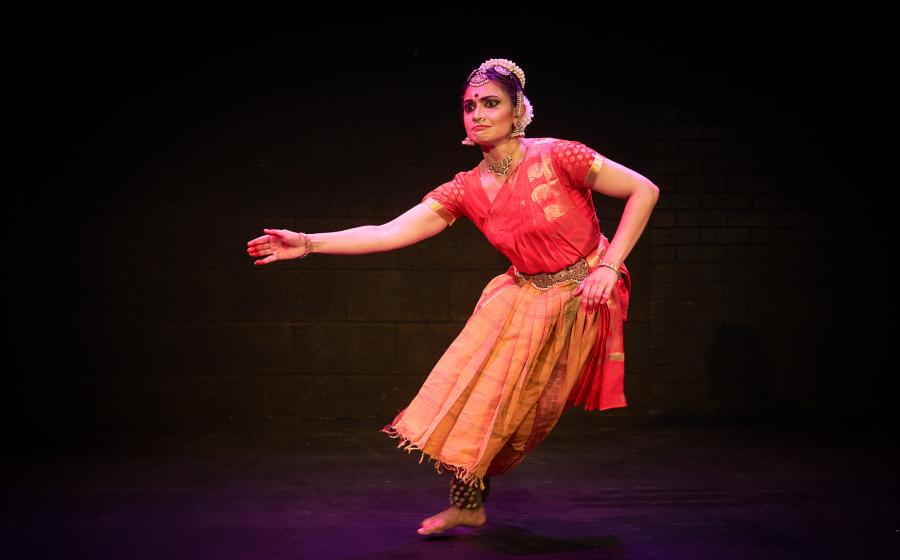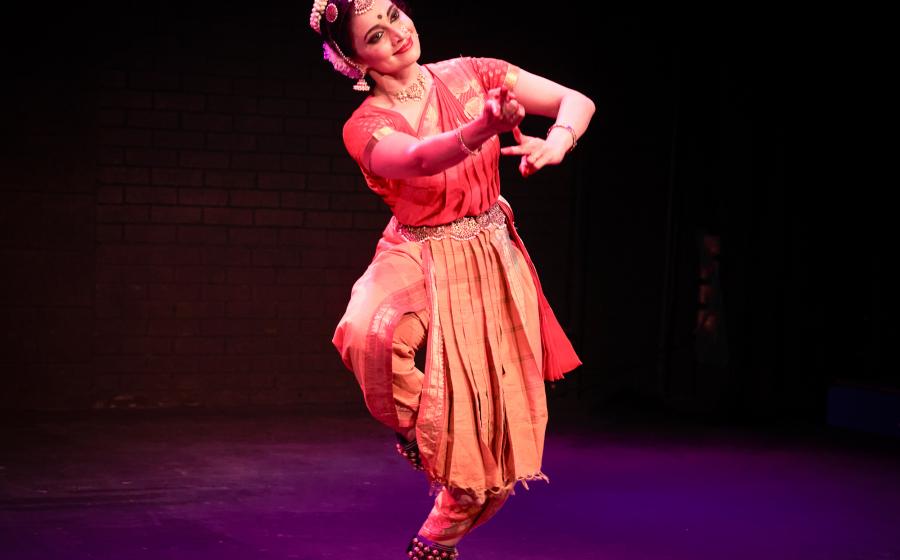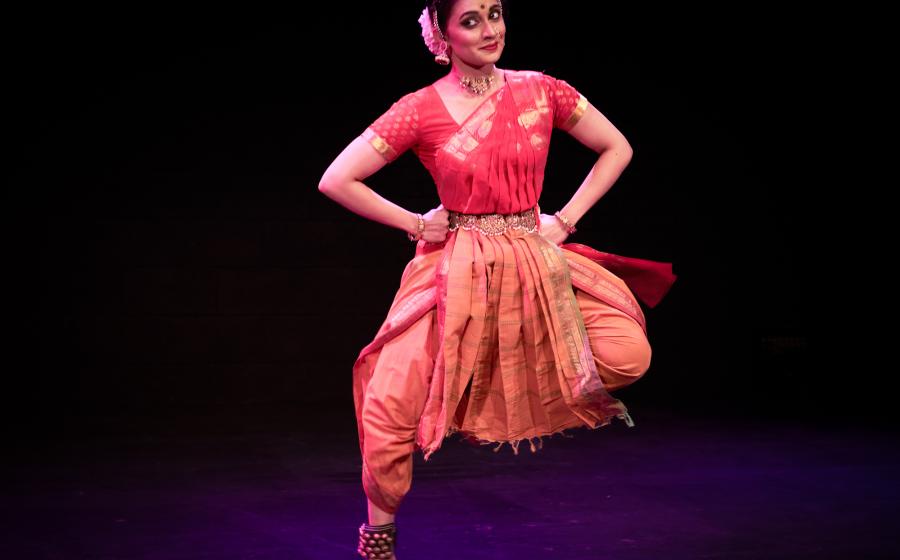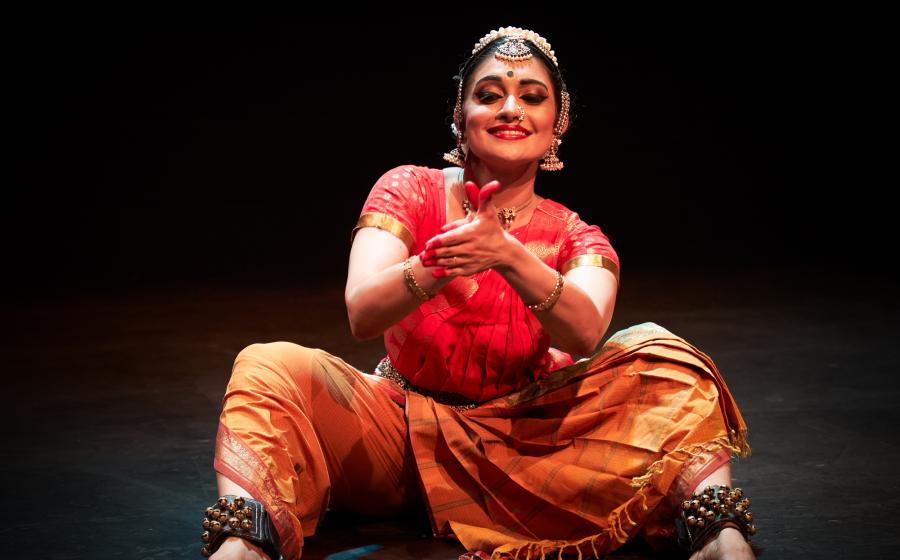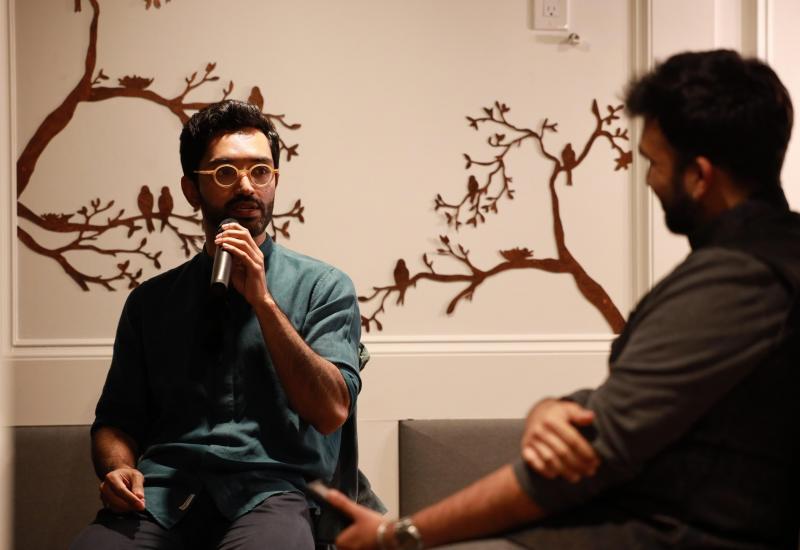Dancing to a New Tune 1: Divya Ravi’s VitthāMāi
This Mini-series examines the connection between new musical compositions and how these elicit new ways of moving, which may or may not be outside the strict classical form. Over 2023 in my normal course of attending performances and keeping abreast of developments in South Asian dance, I came across the works of three dancers which stood out for their freshness and originality. A large part of the appeal was the musical score to the dance which in turn influenced the choreography.
In the case of Divya Ravi, the seamless transition between Carnatic and the Marathi bhajan tradition of Abhanga resulted in high energy jumps and leaps from folk dance; a completely new structure for an odissi Mangalacharan (invocatory item) by Arushi Mudgal; and a Western-influenced score which eschews lehra (the repetitive refrain) which accompanies kathak dance in Amina Khayyam’s Birds. I had the good fortune of conversing with the three dancers..
We open the Series with Divya Ravi’s VitthāMāi produced for Spirit of Margazhi Utsav (a digital arts festival) which was initially created as a dance film and which had its première in January 2023. She is currently developing a stage version which will be performed at the Nartan Festival in Leicester on 4 November at the Curve Theatre. The piece is based on the beliefs and practices of the Varkaari Tradition of Maharashtra that considers a specifically male deity as a Mother – 'Māi'. Divya uses the music traditions of the Abhanga.
I watched VitthāMāi, initially on YouTube, and then saw a short excerpt at the Ananda Festival in Bedford. To give a brief context to the piece: VitthāMāi takes four episodes from the lives of Marathi saint-poets of medieval India. The lyrics are based on their writings and collectively these belong to the bhakti tradition, which flourished in India between seventh and tenth century in South India and spread to the North from the tenth century onwards. The essence of bhakti is the devotion and personal connection to a god, most commonly to Vishnu in his various forms. Bhakti incorporates ideas of inclusivity, rejection of caste and a direct relationship between the devotee and his maker: often this love is expressed through music and dance. In Maharashtra the village of Pandharpur is the focal point of the worship of Vitthala – a version of Krishna, where the statue of the deity stands with hands on the waist in an erect posture. Despite the ‘maleness’ of his form Vitthala, also called Panduranga, is regarded both as father and mother.
One of the enduring messages of the piece is the idea of strapping men needing the same love and ‘cradling’ in the arms of the mother as females and children. The idea of unconditional love of the mother for all her children is at the heart of the cult.
Divya Ravi and her musical collaborators, husband Sharan Subramanian for vocals and musical arrangements and rhythm compositions by Srihari Rangaswamy, have created an otherworldly and magical experience helped by atmospheric lighting (Keerthi Kumar) and excellent filming (Arjun Jith). There are four sections in the work based on the writing of Saints: Senanai, the barber, Tukaram, Chokamela the outcast and Janabai, the housemaid. Divya individualises each of the Saints through appropriate movements, dress and carriage: the hesitancy of Chokamela with two steps forward and one back, maintaining a bowed position; the ghoulish projection of Vitthal is brilliantly evoked with turned out legs on heels and raised arms bent at the elbow in a ‘bat-like’ portrayal; Janabi’s carelessly sitting with knees apart and head-thrown back savouring the oil massage. The range of movements deployed, the detailing of gesture and expression matched by the sympathetic vocals and mridangam’s strokes harmonise. At one point I can hear Sharan’s voice dripping with karuna compassion that elucidates the concept of a mother’s unconditional love for her children.
The piece builds up to a crescendo as Janabi requests, ‘Deva, Abhanga bolo’, ‘Deity please sing the abhang’ and the dancer launches into an ecstatic series of movements covering space with leaps and jumps. It is Vitthala himself who breaks out in dance.
On further viewing I can appreciate how cleverly Divya uses swings, twists and half-circles with the legs to give the feeling of unbridled joy and freedom. The pulsating rhythm that one wants to clap and stamp to increase in speed until one is caught by the frenzy.
You can watch for yourself- the link is given here
To delve further into the making of the piece, I asked Divya about how the music composition and choreography came together.
1. In VitthāMāi you commissioned new music; what were your stipulations to your composer?
VitthāMāi was commissioned by Spirit of Margazhi Utsav and my task was to work on a Tamil Madhurageetam (devotional song) composed by their spiritual teacher, Maharanyam Sri Muralidhara Swami.
Sharan Subramanian (my primary musical collaborator, also my husband) and I selected a few verses from the Tamil Madhurageetam and we instantly were able to match well-known Abhangas (Abhanga is a form of devotional poetry in Marathi sung in praise of the god Vitthal) against each of the Tamil verses, owing to our fascination with Marathi Bhakti poetry over the years. The Marathi verses became an expansion of the essence of the Tamil lyric. There were multiple voices belonging to different poets, so we tied it all back to their subject of obsessive love for the deity ‘Vitthala’ who became VitthāMāi, the matriarch in a chaotic household.
Since most of these compositions (the Madhurageetam and three out of four Abhangas) already had melodic structures in place, my main instruction to Sharan was to seamlessly shift in and out of the Tamil composition and the Marathi Abhangas. We also incorporated rhythmic passages to suit the storyline of each poet. For instance, Tukaram addresses VitthāMāi as a Bhoot (ghoul) that is out to grab him and all passers-by. Visually I imagined this naughty mother: scary but smiling and trying to grab hold of her child - this resulted in a rhythmic section that used the word Bhootam. We layered it rhythmically using multiple voices to sound ‘ghost-like’, and I asked my flautist to overlay notes that gave an eerie effect.
One of the Abhangas (Tulsi Che Bani of Janabai) was not set to music, and I requested the renowned music composer, Rajkumar Bharati, to set this in Raga Dwijavanti. I chose this Raga as I felt it embodied love that sits in the ambiguity between maternal, romantic and platonic and complemented Janabai's emotionscape.
The section on Chokhamela (who was an outcaste), demanded an earthy, tribal feel. The mridangam was too 'classical' for this, and I asked my percussionist to use the khanjira for this segment.
VitthāMāi's musical score involved lots of small, but detailed musical choices and a collaborative effort from musical stalwarts.
2 How would you describe the music of the piece and how does it differ from the music of your repertoire items?
The genre of Abhanga music is a whole world by itself – it is a highly evolved tradition that has developed over centuries. Far from being in a single bucket of 'freestyle' or ‘folk’ art, I believe the Varkari musical traditions are also deeply rooted in embodied rigour and classicism. But there's an element of abandon and freedom – probably arising from the ethos of the Bhakti movement that propagated the idea of accessibility of a personal godhead rather than idolising the deity within the lofty temple walls. The geographic position of Maharashtra also gives it the advantage of influences from both Carnatic and Hindustani styles of music.
Most often Abhangas are sing-song, lofty and magnetically pull everyone in – tying back to the cultural originals stemming from togetherness and community. We can’t ignore their lyrical virtuosity – Abhangas intelligently embed esoteric and philosophical concepts into verses that sound like accessible everyday rants; mirroring the Bhakti movement that made the spiritual accessible. All of this contributes to this distinct musical genre of Abhangas.
The bharatanatyam repertoire is traditionally based on Carnatic music and lyrics in South Indian languages (Tamil, Telugu and Kannada). But honestly, this is all continuously evolving, and it is not uncommon to see Hindustani-based compositions and lyrics in various languages in today’s repertoires.
3 The free style movements which depart from bharatanatyam adavus are skilfully woven in the dance; are these improvised or derived from a named folk style?
I derived a lot of inspiration from Maharashtra folk dance forms – ‘Lavani’, ‘Dindi’ and ‘Kala’ while choreographing VitthāMāi. For the segment on the ghost, I also drew ideas from folk forms of ‘Bhoota Kola’ from Karnataka, ‘Theyyam’ from Kerala and Christopher Bruce’s ‘Ghost Dances’. But I wouldn’t say that my presentation departed from bharatanatyam adavus – rather it is an extension of the existing movement vocabulary. I could break down every single posture and movement I’ve used in VitthāMāi to specific bharatanatyam adavus or chāris existing in the Natyashastra. A small variation, a musical deviation, is all it takes to make the grounded look breezy. That’s been my search while creating this work – how do I transpose a particular folk-movement that works for the mood, onto an existing adavu pattern?
The takeaway for me was the robustness, versatility and fertility of bharatanatyam to welcome varied influences and still retain the core of its form.
4 How does it feel to incorporate free movement?
I already find freedom in just the rigour and discipline of the form of bharatanatyam, even when doing a demanding ‘Kuditthu Mettu’ or ‘Mandi’ adavu. Over the years, I’ve come to befriend the form for all it offers, and my dancing body has learnt to find freedom within the structure.
My primary role as a choreographer is to serve the concept. But as a performer, I only work with the form bequeathed to me - bharatanatyam. The exciting part is being both at the same time – ambitiously finding new ways to move, taking inspiration from other art forms, while stringently being a bharatanatyam Dancer.
I’m always on the verge of collapsing at the end of VitthāMāi – that’s how physically demanding and intense the last piece (‘Nache Panduranga’) is. That it appears to be ‘free movement’ is a compliment that the choreographer in me will gladly take.
5 Do you feel that there is a trend towards opening up the classical repertoire?
The bharatanatyam repertoire has continuously been evolving over the decades, as any living art form rightfully would – both in terms of content and format. Sringara-based literature paved the way for Bhakti-based compositions during the reformist movements, but to this day, Sringara’s position in the repertoire stands strong and uncontested. Over the years, socially and politically significant literature has also worked its way into the repertoire, questioning the relevance of Sringara and Bhakti. Language is no longer a barrier, and one finds poetry from diverse languages incorporated into bharatanatyam. Of course, some of these trends stand the test of time; some disappear for good; and some re-emerge every now and then. What hasn’t changed for bharatanatyam (and hopefully won’t in future) is that the repertoire offers a fertile ground for development of narrative, expressive, emotive and experiential themes amidst the virtuosic movement vocabulary.

